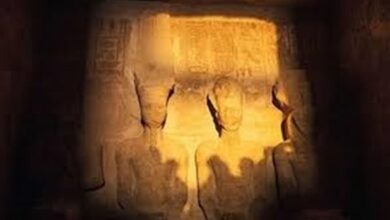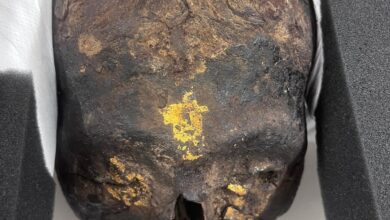Based on uncovered artifacts and historical records, it is well known that ancient Egyptians shared a fondness for certain things—animal-headed deities, elaborate architecture and scientific innovation, to name a few. Another, previously unrevealed, shared affinity: jazz hands.
On 25 October, Ancient Egypt’s youngest pharaoh was brought back to hip-swinging, spear-twirling life in the form of Tut Ankh Amon: The Musical—a boisterous stage production conceived by the Austrian Quadrovision Vienna theater company and presented in collaboration with the Cairo Opera Ballet Company and Orchestra. The production, which premiered two years ago in Austria, tells the story of how the young pharaoh came to power, and the problems he faced during his relatively brief reign—caused, for the most part, by the envious and power-hungry general, Haremhab.
Over the course of two acts and thirty songs, the audience witnesses… well, not much. In terms of plot, Tut Ankh Amon leaves a lot to be desired. At times, the corpse-like pace and repetitive, oversimplified plot make the production’s subtitle, "Eternity Lies in Every Moment,” seem like a cruel, but accurate, joke.
There’s barely any conflict—Haremhab’s plotting is done mostly behind Tut’s back, and to inconsequential effect, and the young pharaoh only realizes he’s been yearning for the love of his life, childhood friend Ankhesen Amon, after she’s brought to him. There’s no searching, no longing or painful heartache, just a convenient and effortless reunion.
To be fair, a musical is not a work of serious drama. And, as a musical production, Tut Ankh Amon definitely has at least two strong points, both of which can be found in Kerstin Ibald’s dual performances as Tut’s grandmother and later, somewhat disturbingly, his prospective Nubian bride. Ibald’s powerful voice and charismatic presence tower over the rest of the cast’s abilities. The young actor portraying Tut Ankh Amon during his childhood years also gives an excellent performance, although his name is nowhere to be found in the production’s booklet or promotional material. Unfortunately, Jesper Tyden doesn’t fare as well in the lead role of the 19-year-old Tut Ankh Amon. The Swedish actor does a fine job with his spoken lines, but when it comes to the many, many songs he performs, Tiden’s voice is easily drowned out by the music.
The music itself is frustrating. Besides a few soppy ballads, the songs aren’t terrible—but the prerecorded drums, keyboards and wailing electric guitars most definitely are, and they do a great disservice to everyone involved by adding a highly unnecessary 80's power-rock vibe. Despite the orchestra’s best efforts, the result is less Cats, more "Eye of the Tiger."
Tut Ankh Amon: The Musical could have benefited from musical numbers that push the story forward, or in any direction. Instead, the songs mainly consist of characters singing thoughts and intentions already spoken in previous scenes, and bound to be repeated in following ones.
The set design was also a source of frustration. One might expect the story of Tut Ankh Amon to reflect the opulence of Ancient Egypt, but, throughout the production’s two-and-a-half-hour running time, the set design remains the same, regardless of where the action is—in the palace, the marketplace or the desert. Set designer Eduard Neversal contents himself with a few sliding panels of hieroglyphic-covered walls and some computerized background projections. On a few occasions, three flat cardboard columns are lowered onstage, but they wobble so badly the audience would be forgiven for thinking the intended effect was to depict the characters’ intoxication.
Seeing as the production is historically inaccurate—a fact made clear to the audience through a pre-show announcement—writer Sissy Gruber could have at least come up with something, anything, to add excitement to the dull story. Sadly, even the events that beg for dramatization are mostly neglected, such as Tut’s mysterious death, which remains unexplored.
Tut Ankh Amon: The Musical seems to be one talking animal away from being a Disney production, and one of the worse ones (Hercules or Tarzan, say). There’s the young, selfish but essentially pure-hearted hero who quickly learns how to be a better person; there’s the chubby and clumsy comic relief (Martin Berger as civil servant Ofir); and, of course, the exotic setting. One ballad, sung by Tut and his lover Ankhesen Amon (Franziska Schuster) even sounds like Aladdin’s “A Whole New World.” Most Disney of all, though, is the villain Haremhab, flamboyantly portrayed by Drew Sarich, who, thumbs to his chest and minions by his side, struts around, belting out tune after tune celebrating how evil he is. The fact that he fails to turn into a dragon or giant snake by the end of the performance was, for this reviewer, the night’s biggest surprise.
Still, for people who enjoy showtunes and musicals, Tut Ankh Amon: The Musical should provide a few minutes of solid entertainment. Advice: take a pair of binoculars and make a game of trying to spot the Asian ancient Egyptian backup dancer.
Tut Ank Amon: The Musical will be performed at the Main Hall of the Cairo Opera House on the 26th and 27th of October, at 12PM and 8PM, and also on the 28th at 8PM. The production will then move to the Sayed Darwish Theatre at the Alexandria Opera House for two more shows, held November 1 and 2 at 8PM




